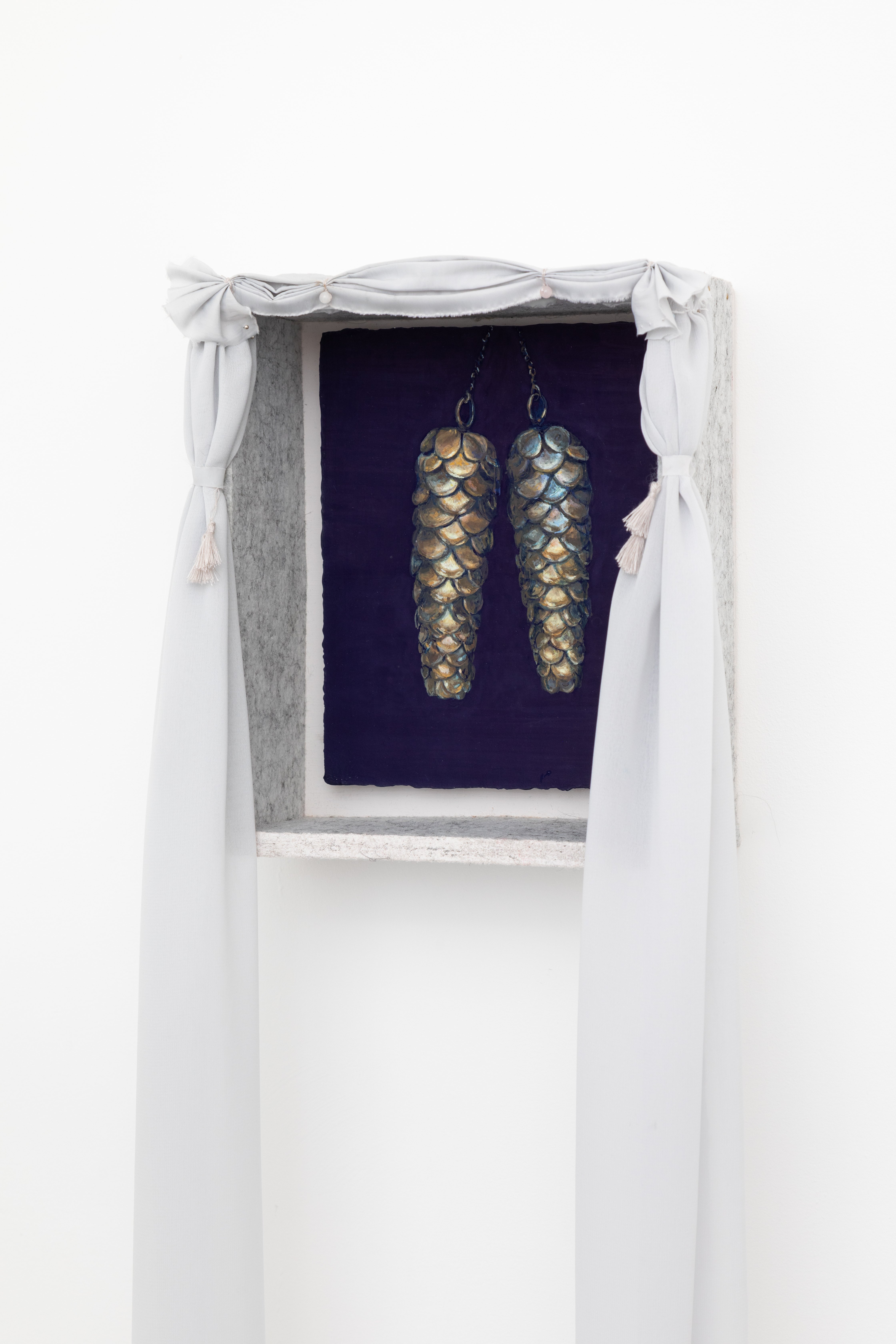


Courtesy the artist and Indigo+Madder, London. Photography by Benjamin Deakin
Indigo + Madder, Kirkman House, 12 – 14 Whitfield Street, London, W1T 2RF
1 December 2023 – 27 January 2024
Come Closer is a collaboration between Indigo+Madder and Netherland-based collective Syzygy, presented in the gallery’s space in Fitzrovia. In this group exhibition, ten local and international artists explore the concept of 'softness' as an artistic and aesthetic methodology, as described in Peter Kærgaard Andersen’s seminal text 'Radical Softness: Artistic Methodology of Encountering the “Other” (2020).' Delving into the realms of vulnerability, emotionality and tenderness, the exhibition aims to challenge patriarchal structures, confront inequality and subvert capitalist consumer culture by offering new, subversive ways to encounter otherness.
Brieke Drost’s small-scale paintings, executed in velvety tempera, capture objects made of precious metals and jewels as she references 17th century vanitas paintings. However, unlike the symbolic assemblages often seen in this genre, Drost's focus lies on singular objects, exemplified by pieces like Pierrot (2018), portraying a historic brooch adorned with pearls, gems and gold. Through delicate brushwork and soft detailing, Drost's depictions not only evoke themes of mortality and vulnerability, but also celebrate a profound yearning for beauty. In dialogue with Drost’s work is a drawing by Kinke Kooi. In Touch (2007) features clothing pins and needles embedded into voluptuous, bulging forms with cavities and crevices, revealing how ‘softness’ can resist sharpness.
Leo Costelloe’s large, hand-made fabric installation Woven Silver Ribbon (2023) drapes from ceiling to floor, dividing the exhibition space. Made from a sheer, pleated material, the installation maintains architectural authority, as Costelloe explores how feminine symbols exist in and subvert patriarchal landscapes. Similarly, desire, joy, and the fantasies of belonging play an important role in both Mohammed Z. Rahman’s and Niamh Porter’s work. Rahman’s Buff Basement (2023), painted on a wooden board, is a deeply personal representation of a queer utopian domestic space. Meanwhile, Niamh Porter’s paintings, such as Peggy Guggenheim’s bedroom (2023), feature domestic interiors and objects that are mostly designed by, or for the use of, women. Alluring, seductive and glamorous, both artists speculate an imagined safe space for emotional vulnerability, questioning fixed gender categories.
On the back wall is Laila Majid’s soft feel 04 (2022). A print work made from a series of cat paw images seen online, it examines how notions of desire, longing and tenderness are mediated through social media. Next to Majid’s print, Tenant of Culture explores ideas of value, consumerism and production by disassembling and rebuilding garments to give rise to new forms. In their series Haul (2023), clothes in pristine packaging materials from online retailers are slashed open, stitched and decorated. Here, Tenant of Culture mimics 16th century ‘slashed sleeve’ decorative techniques, scrutinising fashion trends and their capitalist manufacturing processes.
Qian Qian’s distinctive abstract aesthetics emerge from her interest in mythology, spirituality and science. Through a fluid application of paint and superimposition of translucent layers, her works are hybrid expressions of the spherical form found in Zen Buddhist philosophy, quantum mechanics and sci-fi imagery. In Echo (2023), mollusc-like structures appear alongside vegetal patterns and other symbolic, dreamy imagery as the artist proposes new ways of experiencing form and energy.
Athen Kardashian & Nina Mhach Durban’s seemingly nostalgic assemblages layer pop culture references with images from Bollywood. Be my baby (2023) explores the refashioning of diasporic identity, commenting on otherness, displacement, migration and vulnerability. Mireille Tap’s works utilise emotionality as well as ‘feminised behaviours’ to dwell on issues such as ‘cuteness’ as a survival strategy. I want you to have your period at the same time as me (2023) plays with infantile, ‘cute’ appearances that induce feelings of familiarity and security. Through this however, Tap comments on darker issues such as a lack of adequate housing for young people, negotiating emotional vulnerability through the tensions inherent in her approach.
Overall, Come Closer playfully combats the idea that emotionality, feelings of vulnerability and tenderness are a sign of weakness. The participating artists’ creative vision and interpretation of softness gently - but powerfully - point us to the revolutionary potential and transformative quality of ‘radical softness’ in social change.
If you are ever feeling overwhelmed by last-minute Christmas shopping and the buzz of Oxford Street, I highly recommend you visit this intimate and exquisite group show, just a step away from Tottenham Court Road Station!
Christine Takengny
The Roden Senior Curator, Museum Acquisitions
Indigo + Madder
Kirkman House,12 – 14 Whitfield Street, London, W1T 2RF
Opening Times: Wednesday - Saturday 11am - 6pm and by appointment
Exhibition open until 27 January 2024